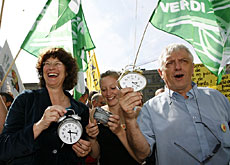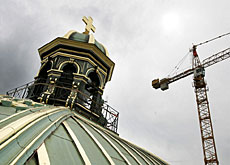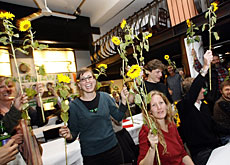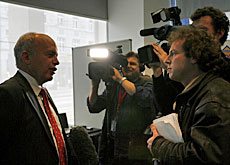Greens bloom after polls but could wither

The Swiss Green Party's success in this weekend's parliamentary elections has prompted speculation that the party could be targeting a seat in cabinet.
But despite their gains, experts warn the Greens still face several challenges, among them internal divisions and their relationship with the centre-left Social Democrats.
The Greens, the country’s fifth strongest party, increased their number of seats in the 200-strong House of Representatives on Sunday to 20, up from 14 in 2003.
The left-leaning party, led by Ruth Genner, also won its first seat in the 46-member Senate. Overall, its share of the vote increased to 9.6 per cent from 7.7 per cent.
A smaller splinter party, the Liberal Greens who are closer to the centre-Right, won three seats in Zurich, Switzerland’s business hub.
In a statement, released on Monday, the Green Party said it had “more than reached our goals” and called the election of a senator representing Geneva, “a milestone”.
Georg Lutz, a political scientist at Bern University, believes that the Greens’ image as the party that cares the most about environmental issues – in an era where many Swiss are worried about global warming – was a key factor in their success. But it was not the only reason.
“They also benefited from the weakness of the Social Democrats who did not manage to have their own political agenda, and because some voters are strongly attached to both parties, many of them voted Green instead of Social Democrat,” Lutz told swissinfo.
Cabinet seat?
Discussions are now focused on whether the Greens will run for a seat in Switzerland’s powersharing government, where seven portfolios are shared between the four main parties. The next cabinet elections are due in December.
The Green Party has not yet ruled out this option. But it has called for the People’s Party to be thrown out of government for not following the principle of consensus politics – seen as key to cabinet workings.
Lutz reckons that there is not much chance of the Greens obtaining a seat.
“People think of the government as a kind of proportional representation system but it’s not. It is a system where a parliamentary majority is needed to win a seat. I don’t think such a scenario is likely at all at this stage for the Greens,” he said.
In any case, the other parties – even the Greens’ traditional partner the Social Democrats – would be unwilling to give up their seats, he added.
The Social Democrats – the second largest party in Switzerland – sustained losses in the elections.
The party won back votes from the Green Party during the 1980s – another peak of Green popularity – by moving to the left, said Lutz. Now the situation seems to have swung the other way, but neither party has much leeway to gain more votes.

More
Government, ministers, president
Political direction
A move to the centre may well be the Greens’ next big debate, added the political scientist. The Greens in the French-speaking part of the country are acknowledged to be more to the centre.
Adding fuel to the fire is the success of the Liberal Greens in Zurich. Lutz says the group is still a local phenomenon, but it does have the potential to split the party.
He warns, however, that two smaller camps would weaken the Greens. He also has doubts whether a move to the centre would work.
On a European scale, Green parties have had mixed fortunes of late. Their success often depends on how seriously the other parties take environmental concerns, Lutz explained.
The Swiss Greens have a monopoly on such issues and it is easier to gain parliamentary seats under the Swiss political system, he pointed out. Being in opposition also adds to their appeal.
“I wouldn’t even be sure that it would be good for the Green Party to get a seat in government because they would lose this appeal of being fresh and different and not being part of what goes on behind closed doors,” said Lutz.
swissinfo, Isobel Leybold-Johnson

More
Consensus politics and power-sharing
The Greens won 9.6% of the vote.
They have 20 people in the House of Representatives and 1 in the Senate.
With 10 women and 11 men parliamentarians they have the most equal distribution between the sexes of all the parties.
More than 200 Greens sit in cantonal parliaments.
The first section of the Green Party in Switzerland was established in 1971 in canton Neuchâtel to oppose plans for a new motorway.
They won their first parliamentary seat in 1979. In recent years, the Greens have gained representation in the governments of several cantons. At federal level, they are the fifth-ranking party, but as yet have held no cabinet post.
The Liberal Greens, which are to the right of the political spectrum, were founded in 2004. They are a splinter group from the Zurich Green Party and won 3 parliamentary seats in the elections in Zurich.
The first Green parties appeared in Europe in the 1970s. By the end of the 1980s almost every country in western and northern Europe had a Green party of some kind. They are emerging in eastern Europe.
The German Greens were the first to achieve a strong presence nationally. However, the Finnish party was the first to be part of a cabinet.
Countries where Greens currently hold government posts include Finland, Italy and Ireland.

In compliance with the JTI standards
More: SWI swissinfo.ch certified by the Journalism Trust Initiative




You can find an overview of ongoing debates with our journalists here . Please join us!
If you want to start a conversation about a topic raised in this article or want to report factual errors, email us at english@swissinfo.ch.